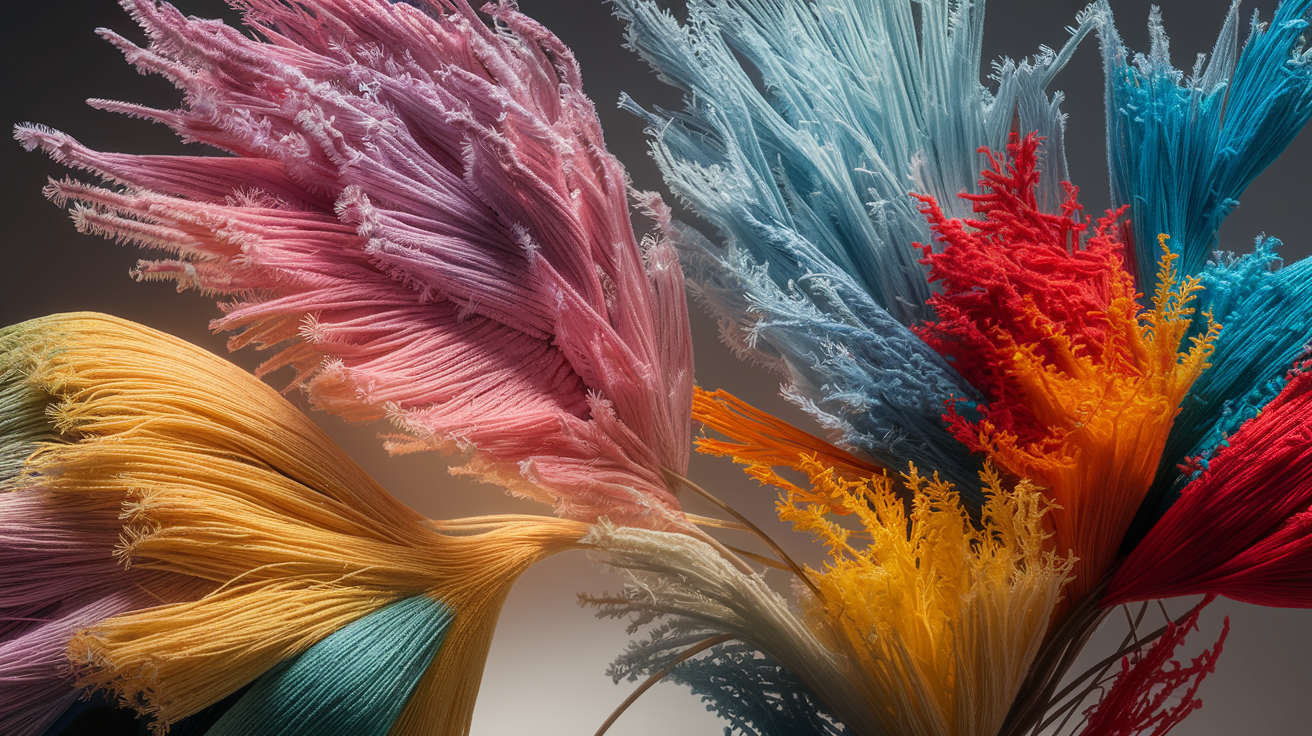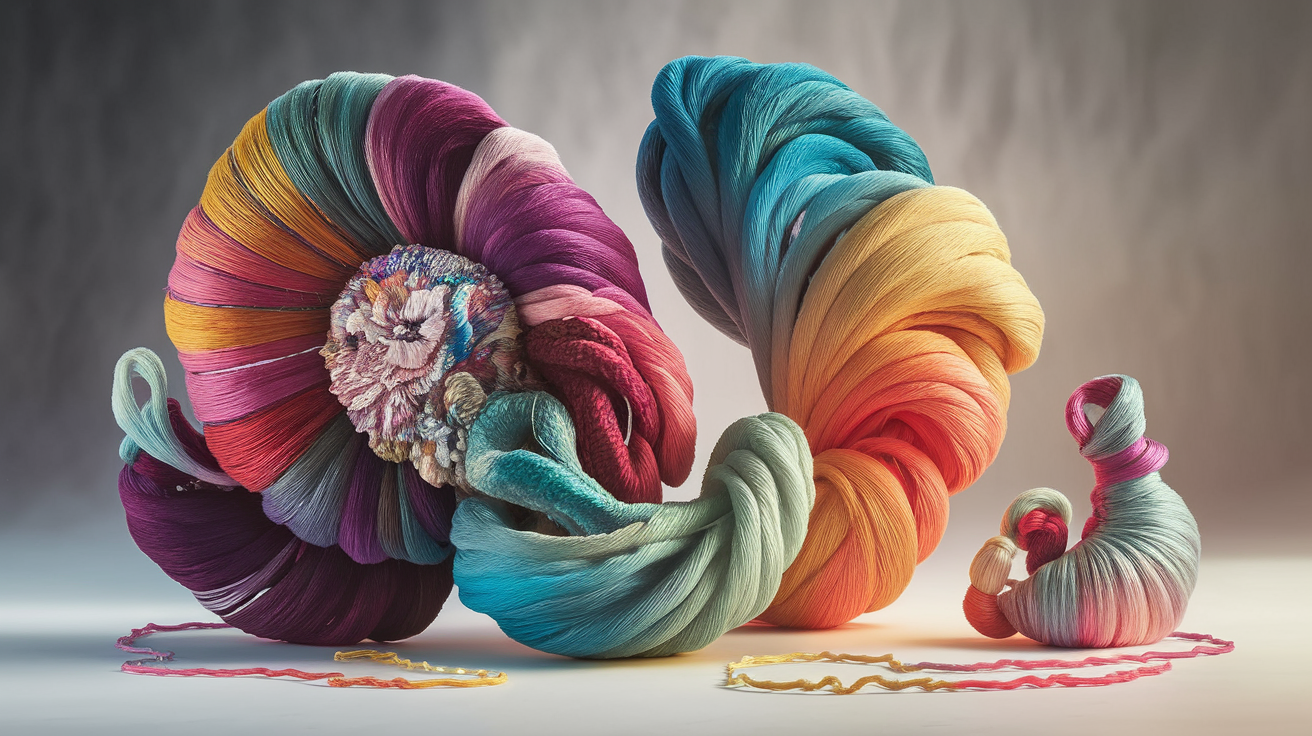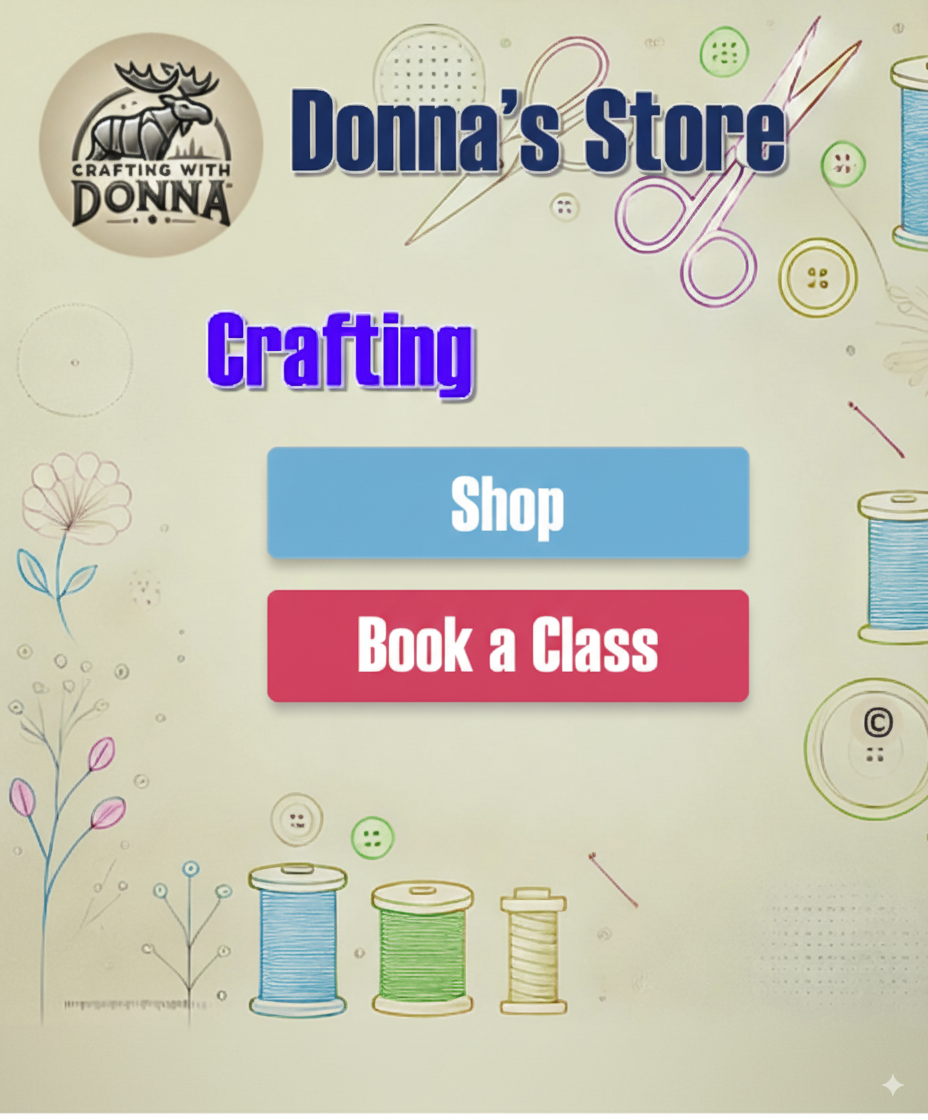Colorful Modern Embroidery Inspiration By Salt Stitches Transforms

Modern embroidery enthusiasts are discovering a vibrant world of contemporary needlework, thanks to the innovative approach of Salt Stitches. This Manchester artist, Emily Botelho, masterfully blends field photography of British beaches and rugged coastlines with rich hand embroidery.
Her abstract textile art reimagines traditional techniques, creating pieces with remarkable textural and visual depth.
Salt Stitches’ distinctive use of vibrant color palettes and natural materials like seashells and artisanal beads results in truly standout creations, offering boundless inspiration for anyone passionate about mixed media fiber art.
Exploring Salt Stitches Abstract Textile Art
Salt Stitches’ abstract textile art offers a unique journey into coastal textures, reinterpreted through the nuanced language of thread and mixed media fiber art.
Emily Botelho, a Manchester artist, draws deeply from nature-inspired stitching, finding inspiration in lichen textures, rock patterns, and seaweed motifs found along UK landscapes and North American landscapes. She employs experimental threads and contrasting hues to capture organic forms and natural phenomena, transforming cotton base and linen fabric into captivating surfaces.
This approach to hand embroidery breathes new life into contemporary needlework, allowing for creative compositions that resonate with viewers on a profound level.
The Art of Transformation
The transformation of base cloths is a hallmark of Emily Botelho’s abstract embroidery. She begins by capturing field photography of British beaches and rugged coastlines, using these images as a foundation for her artistic vision.
These photographic prints are then applied to fabric, serving as a guide for stitching and color choices, allowing for an interplay between the original image and the overlaid embroidery.
This process, often described as surface transformation, is where the magic truly happens, creating dimensional elements that add significant visual interest and tactile elements to each piece.
The exploration of thread thickness, the combination of matte threads and lustrous threads, and the daring use of surprising color pairings, often deviating from traditional palettes, all contribute to the unique character of Salt Stitches’ work. Her freeform stitching and dimensional embroidery techniques allow for a playful interaction with the medium, encouraging viewers to engage with the art on multiple sensory levels.
Embracing Nature’s Palettes
Salt Stitches’ creative process is deeply rooted in observation of the natural world, translating the subtle beauty of lichen textures, rock patterns, and moss inspiration into tangible art.
This nature-inspired stitching involves a careful selection of materials, including artisanal beads, semiprecious stones, and natural materials like seashells, which are integrated to enhance the unique textures and add depth to the compositions. The vibrant color palettes are thoughtfully curated, often featuring unexpected color combinations that mimic the surprising beauty found in nature, such as in tide pool art.
These sketchlike inspirations from landscape photography lead to creative compositions that are both visually striking and deeply evocative.
The artist’s willingness to explore challenging color choices, moving beyond conventional approaches, consistently yields standout results, making her abstract textile art a source of wonder and admiration for her ever-growing Instagram community and international collectors alike.
Connecting and Creating
Salt Stitches has cultivated a strong social media engagement, fostering a global community drawn to Emily Botelho‘s unique artistic vision.
Her influence extends beyond inspiration, with popular embroidery kits and sold-out workshops that empower others to explore their own creative spontaneity and practice selfcare art. The brand’s evolution is evident in its reach, connecting with international collectors and participants from both the UK and North American landscapes.
This community development is integral to the Salt Stitches ethos, creating a space for shared learning and appreciation of contemporary needlework. The artist’s brand evolution continues, marked by limited edition auctions and a growing appreciation for her distinct blend of photography and embroidery.

What is Hand Embroidery?
Hand embroidery transforms plain fabric into expressive, tactile art using a needle and thread—a process that allows for endless experimentation in both traditional and modern embroidery. Stitches like the backstitch, satin stitch, and French knot introduce texture and depth, making each design uniquely dimensional; these foundational techniques form the backbone of creative compositions for beginners and advanced crafters alike.
Material exploration is essential.
Try working with a cotton base, linen fabric, or even photographic prints as base cloths, then incorporate experimental threads and natural materials for standout results, following inspiration from Salt Stitches.
Emily Botelho, at Salt Stitches, emphasizes this surface transformation. As a beginner tip for sourcing unique threads, look beyond standard floss at craft fairs and thrift shops to achieve vibrant color palettes and create truly original pieces with surprising color pairings.
The thread thickness, from matte threads to lustrous threads, can also influence the final texture. From Manchester artist Emily Botelho’s abstract textile art, we learn that contrasting hues can bring surprising color pairings to traditional palettes for standout results.
Discover Contemporary Needlework Techniques
Contemporary needlework continually evolves through innovative methods that turn simple stitches into three-dimensional, visually dynamic fiber art.
Sculptural embroidery introduces dimension by layering fabrics and adding tactile elements like artisanal beads, semiprecious stones, and seashells, creating unique textures and depth.
This approach is exemplified by the abstract textile art of Emily Botelho of Salt Stitches, known for bold, vibrant color palettes inspired by British beaches and rugged coastlines.
Artists, like the Manchester artist and Canadian artist Emily Botelho, bridge styles by blending photography and embroidery. They utilize photographic printing as the foundation for hand-stitched, layered embellishments and dimensional elements, creating unexpected color combinations and compelling visual interest.
For those inspired by mixed media fiber art, combining organic forms and experimental threads transforms conventional embroidery into standout, contemporary masterpieces. This approach to nature-inspired stitching can draw from lichen textures, rock patterns, or seaweed motifs; these sketch-like inspirations guide the freeform stitching.
Emily Botelho’s work showcases dimensional embroidery, using field photography and contrasting hues to capture natural phenomena, such as moss inspiration or tide pool art, creating depth and visual interest on cotton base or linen fabric.
This selfcare art emphasizes creative spontaneity, and her social media engagement on Instagram, where Salt Stitches has a large community of international collectors, highlights the brand evolution and community development fueled by creative compositions and a focus on UK landscapes and North American landscapes.
Salt Stitches also offers embroidery kits and has held soldout workshops and limited edition auctions, reflecting a deep connection to landscape photography.
- Hand embroidery transforms fabric into art using a needle and thread, with stitches like backstitch and French knots adding texture and depth.
- Contemporary needlework, exemplified by Emily Botelho of Salt Stitches, incorporates tactile elements like artisanal beads and semiprecious stones for sculptural effects.
- Artists like Emily Botelho blend photography with embroidery, using photographic prints as a base for layered embellishments and dimensional elements.
- Inspiration for contemporary embroidery can be drawn from nature, such as lichen textures, rock patterns, or seaweed motifs, guiding freeform stitching.
Absolutely! Here is the refined content:
Embracing Coastal Textures in Fiber Art
Emily Botelho’s approach to abstract textile art, widely known as Salt Stitches, artfully translates natural coastal elements into deeply engaging fiber creations. Observing the textures of British beaches and stark, rugged coastlines serves as a primary source of inspiration, often beginning with photographic printing of natural phenomena onto cotton base or linen fabric for experimental freeform stitching.
To effectively achieve granular, sand-like textures, consider using boucle or slub yarns, scattered artisanal beads, or tightly executed colonial knots, while wavy running stitches or mulberry bark can mimic the fluid movement of water, bringing a sense of realness to your work.
Blending varied thread thicknesses, including both matte threads and lustrous silk, alongside incorporated seashells or semiprecious stones, greatly expands the dimensionality and authenticity of each mixed media fiber art piece, truly echoing the unpredictable, rich textures discovered along the shore.
How to Use Vibrant Color Palettes
Vibrant color palettes are pivotal in contemporary needlework, guiding the viewer’s eye and enhancing creative compositions, a notable characteristic of Salt Stitches’ distinctive style.
Drawing from unexpected color combinations, such as pairing deep ocean blues with mossy greens or striking lichen yellows, artists can venture beyond traditional palettes to achieve truly standout results and imbue their work with profound emotional depth. Embracing the psychological impact of distinct hues becomes a powerful tool; a sudden flash of warm orange might effectively convey sunlight glinting on waves, while serene teals or deeply saturated pinks can introduce essential visual interest and establish clear focal points.
Utilize the principles of the color wheel to harmonize bold shades and deliberately integrate at least one challenging color per piece, much like Emily Botelho does, to invigorate your abstract textile art with imaginative, nature-inspired stitching and dynamic transitions between hues.
- Emily Botelho’s abstract textile art, known as Salt Stitches, is inspired by the textures of British beaches and coastlines.
- Techniques for achieving coastal textures include using boucle or slub yarns, artisanal beads, colonial knots, wavy running stitches, and mulberry bark.
- Incorporating mixed media elements like seashells and semiprecious stones enhances the dimensionality of fiber art pieces.
- Vibrant color palettes in needlework guide the viewer’s eye and can be achieved through unexpected color combinations, such as deep ocean blues with mossy greens.
Creative Compositions with Natural Materials
Integrating Organic Matter into Textile Art
Salt Stitches, the renowned textile art initiative by artist Emily Botelho, expertly integrates natural materials into stunning pieces of abstract textile art, creating rich coastal textures that imbue the surface with unexpected depth and vibrancy. Creative compositions frequently commence by carefully arranging dried leaves, delicate seaweed, or polished seashells onto a sturdy cotton base.
These elements are then secured using intricate hand embroidery techniques such as couching or appliqué, sometimes supplemented with subtle archival adhesives, ensuring their long-term preservation and integrity throughout the creative process.
These carefully selected natural materials are meticulously pressed and dried, effectively guarding them against deterioration while preserving the tactile memory of distant British beaches.
A vital aspect of this practice is sustainable sourcing: artists are encouraged to gather materials ethically, repurpose local finds judiciously, and prioritize botanicals procured from environmentally conscious suppliers, all to honor the natural world and achieve truly nature-inspired stitching for subsequent artistic endeavors.
Sustainable Sourcing for Coastal Textures
Embracing sustainable sourcing for your textile art means consciously gathering materials ethically from environments like British beaches and rugged coastlines. Repurposing local finds fosters a deeper connection to place.
Prioritizing botanicals from eco-friendly suppliers helps honor the environment. This mindful approach achieves truly nature-inspired art that resonates with authenticity and respect for the planet.
Consider the memory of British beaches when selecting your components.
This approach to sustainable sourcing ensures the integrity of your natural materials.
The result is art that reflects a profound connection to place, enhancing the coastal textures and overall narrative of your work. It’s about creating beauty responsibly.
Natureinspired Stitching: A Closer Look
Translating Natural Forms into Stitches
Abstract textile art from the Salt Stitches collection masterfully demonstrates how textile artisans can translate the rhythmic flow of seaweed motifs and the intricate patterns of lichen textures into innovative hand embroidery stitches.
This style of contemporary needlework utilizes directional stitching, carefully layered threads, and vibrant color palettes to effectively convey both the intricate detail and dynamic movement found within nature, allowing organic forms to emerge organically from the fabric surface. Observational exercises, such as creating texture rubbings of weathered rocks or meticulously photographing moss inspiration, translate naturally into unique and expressive stitch patterns that capture the essence of the natural world.
By embracing creative compositions and thoughtfully experimenting with surprising color pairings, artists unlock potent new forms of expression while simultaneously deepening their intrinsic connection to the evocative beauty of North American and UK landscapes and their inherent coastal inspirations.
Mimicking Patterns Found in Nature
Mimicking patterns found in nature through stitches involves close observation of lichen textures and rock patterns.
This artistic pursuit translates the essence of seaweed motifs into tangible fibre art.
Employing hand embroidery, artists can replicate the delicate veins of a leaf or the rough surface of a stone. Field photography serves as a valuable tool, capturing fleeting moments of natural beauty for later interpretation.
Creating sketchlike inspirations from these observations guides the stitching process. Utilizing a cotton base or linen fabric provides a robust canvas for this detailed work.
The surface transformation achieved through varied thread thickness adds a crucial tactile dimension.
Matte threads alongside lustrous threads create dynamic visual interest.
- The textile art initiative Salt Stitches by Emily Botelho integrates natural materials like dried leaves, seaweed, and seashells into abstract textile art.
- Techniques such as couching and appliqué are used with hand embroidery to secure natural materials onto a cotton base.
- Sustainable sourcing is encouraged, emphasizing ethical gathering, repurposing local finds, and prioritizing botanicals from environmentally conscious suppliers.
- Artists translate natural forms, such as seaweed motifs and lichen textures, into hand embroidery stitches, using observational exercises and field photography for inspiration.
Bridging Traditional and Modern Embroidery
Reimagining Heritage Through Contemporary Artistry
The essence of modern embroidery lies in its ability to breathe new life into heritage techniques. Ancient stitches now form the backbone for cutting-edge contemporary needlework projects, demonstrating how heritage can be reinterpreted.
Salt Stitches, the brainchild of Emily Botelho, expertly illustrates the fusion of historical motifs with contemporary aesthetics.
This approach connects directly to the exploration of contemporary needlework, showcasing a project that successfully blends eras.
Botelho’s work often begins with field photography of lichen, rocks, and seaweed, translating their textures and hues into sketch-like inspirations for her art.
A Case Study in Fusion
Emily Botelho’s Salt Stitches project offers a compelling case study of how heritage techniques can be reinterpreted.
She examines the fusion of historical motifs with contemporary aesthetics, connecting to the exploration of contemporary needlework. Her process embraces nature-inspired stitching, often drawing from British beaches and rugged coastlines, to inform her designs.
The art effectively connects to the exploration of contemporary needlework, presenting a case study of a project that successfully blends eras.
She utilizes photographic printing as a foundational layer, over which hand embroidery and embellishments are applied.
These include artisanal beads and semi-precious stones, providing captivating texture and depth.
The Creative Process of Salt Stitches
Salt Stitches, led by artist Emily Botelho, is internationally recognized for its modern abstract embroidery.
This art features vivid, unexpected color palettes and creative compositions. Drawing inspiration primarily from natural coastal textures, her work redefines traditional embroidery through innovative techniques and a contemporary artistic lens.
Botelho combines photography from British beaches and rugged coastlines with embroidery, printing images onto fabric.
She then layers these with bold hand-stitched embellishments.
The practice integrates beads, semi-precious stones, and natural materials like seashells into the panels to create unique textures and depth. Vibrant threads and experimental, often contrasting colors reinterpret organic forms and natural phenomena.
Botelho embraces freedom from conventional stitch rules, allowing organic shapes and layered dimensionality as focal points.
Practical Inspiration for Embroiderers
To achieve standout results, consider using photographic prints as base cloths to guide your stitching and color choices.
Incorporate dimensional elements like beads, shells, or stones for visual and tactile interest.
Challenge yourself with at least one clashing or surprising color in each piece, moving beyond traditional palettes.
Let natural phenomena—rocks, moss, tide pools—inspire new motifs and textures in your work. Experiment with thread thickness and the interplay between matte and lustrous materials.
Consider the benefits of self-care art and creative spontaneity in your practice.
Emily Botelho, a Manchester artist who has relocated to Canada, roots her art in both UK and North American coastal landscapes.
Salt Stitches boasts over 70,000 Instagram followers, fostering a dedicated international community of collectors and students.
Her offerings include embroidery kits, sold-out workshops, and limited-edition auctions.
Landscape photography serves as the starting point for each composition, contributing to the brand evolution and community development through social media engagement.
- Salt Stitches, by Emily Botelho, reinterprets heritage embroidery techniques by blending historical motifs with contemporary aesthetics.
- Botelho’s creative process involves using field photography of natural coastal textures (lichen, rocks, seaweed) as inspiration for her embroidery designs.
- The Salt Stitches project incorporates photographic printing as a base layer, enhanced with hand embroidery, artisanal beads, semi-precious stones, and natural materials like seashells.
- Emily Botelho’s Salt Stitches has a significant international following of over 70,000 Instagram followers, indicating a strong community and market for her modern abstract embroidery.




